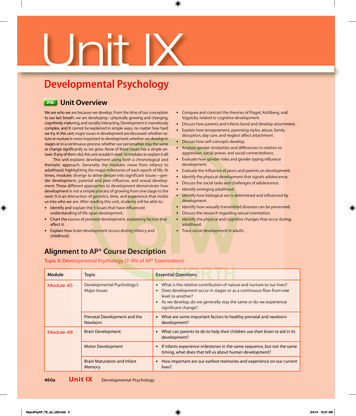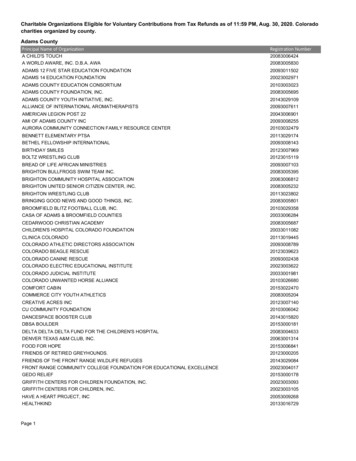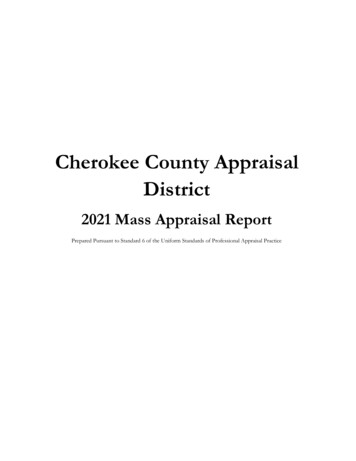
Transcription
Unit IXDevelopmentalDllPPsychologyh lPDUnit OverviewWe are who we are because we develop. From the time of our conceptionto our last breath, we are developing—physically growing and changing,cognitively maturing, and socially interacting. Development is marvelouslycomplex, and it cannot be explained in simple ways, no matter how hardwe try. In this unit, major issues in development are discussed: whether nature or nurture is more important to development; whether we develop instages or in a continuous process; whether our personalities stay the sameor change significantly as we grow. None of these issues has a simple answer. If any of them did, this unit wouldn’t need 10 modules to explain it all!This unit explains development using both a chronological andthematic approach. Generally, the modules move from infancy toadulthood, highlighting the major milestones of each epoch of life. Attimes, modules diverge to delve deeper into significant issues—gender development, parental and peer influence, and sexual development. These different approaches to development demonstrate howdevelopment is not a simple process of growing from one stage to thenext: It is an interaction of genetics, time, and experience that moldsus into who we are. After reading this unit, students will be able to: Identify and explain the 3 issues that have influencedunderstanding of life-span development. Chart the course of prenatal development, explaining factors thataffect it. Explain how brain development occurs during infancy andchildhood. Compare and contrast the theories of Piaget, Kohlberg, andVygotsky related to cognitive development. Discuss how parents and infants bond and develop attachment. Explain how temperament, parenting styles, abuse, familydisruption, day care, and neglect affect attachment. Discuss how self-concepts develop. Analyze gender similarities and differences in relation to aggression, social power, and social connectedness.Evaluate how gender roles and gender typing influencedevelopment.Evaluate the influence of peers and parents on development.Identify the physical development that signals adolescence.Discuss the social tasks and challenges of adolescence.Identify emerging adulthood.Identify how biological sex is determined and influenced bydevelopment.Identify how sexually transmitted diseases can be prevented.Discuss the research regarding sexual orientation.Identify the physical and cognitive changes that occur duringadulthood.Trace social development in adults.Alignment to AP Course DescriptionTopic 9: Developmental Psychology (7–9% of AP Examination)ModuleTopicEssential QuestionsModule 45Developmental Psychology’sMajor Issues What is the relative contribution of nature and nurture to our lives? Does development occur in stages or as a continuous flow from onelevel to another? As we develop, do we generally stay the same or do we experiencesignificant change?Module 46Prenatal Development and theNewborn What are some important factors to healthy prenatal and newbornBrain Development What can parents to do to help their children use their brain to aid in itsdevelopment?development?Motor Development If infants experience milestones in the same sequence, but not the sametiming, what does that tell us about human development?Brain Maturation and InfantMemory460aUnit IXMyersPsyAP TE 2e U09.indd 2 How important are our earliest memories and experience on our currentlives?Developmental Psychology3/4/14 10:21 AM
ModuleTopicEssential QuestionsModule 47Piaget’s Theory and Current Thinking Why is Piaget’s theory so important?An Alternative Viewpoint: LevVygotsky’s Scaffolding Why is Vygotsy’s theory important to our understanding ofReflecting on Piaget’s Theory What important points can we learn from Piaget and Vygotsky?Origins of Attachment Why is becoming attached to someone else important?Attachment Differences:Temperament and Parenting How do temperament and parenting influence our development?Deprivation of Attachment How influential can deprivation of attachment be to a person?Day Care What qualities should people look for in a day care?Self-Concept How is self-concept different from self-esteem?Parenting Styles What factors about parenting influence future behavior in children?Culture and Child Raising How do child-raising practices vary between cultures?How Are We Alike? How Do WeDiffer? How do people of different genders handle situations in similar ways? How do people of different genders handle situations in different ways? Are these differences important?The Nurture of Gender: Our Culture How much influence does culture have on your gender role?Parents and Early Experiences How much credit or blame do parents deserve for their children’sModule 48Module 49Module 50development?behavior and life outcomes?Peer Influence How do peers influence your gender role?Module 51Cognitive Development How do adolescents think differently from children and adults?Module 52Forming an Identity How does one form an identity? How important is it for adolescents to form an identity?Parent and Peer Relationships Who has more influence on a person’s behavior and choices: parents orpeers?Emerging Adulthood Is the development of emerging adulthood a good or bad thing?Module 53Sexual Orientation What has research taught us about sexual orientation?Module 54Physical Development Is adulthood only a time of physical deterioration?Cognitive Development How do adults change cognitively as they age?Social Development Do adults have a social life? How is it similar and different from anadolescent’s social life?Developmental PsychologyMyersPsyAP TE 2e U09.indd 3Unit IX460b3/4/14 10:21 AM
Unit ResourcesModule 45Module 48STUDENT ACTIVITYSTUDENT ACTIVITIES Fact or Falsehood? FLIP IT VIDEO TeratogensModule 46Fact or Falsehood?Social DevelopmentTemperament on the WebEAS Temperament SurveyParental Authority QuestionnaireFLIP IT VIDEOSTUDENT ACTIVITIES Fact or Falsehood? Identifying Developmental Landmarks Attachment Styles and ParentingModule 49FLIP IT VIDEO Major Developmental MilestonesModule 47STUDENT ACTIVITY Fact or Falsehood?Module 50TEACHER DEMONSTRATIONS Lollipops and Gloquex Demonstrating Preoperational ThoughtSTUDENT ACTIVITIES STUDENT ACTIVITY Fact or Falsehood?Module 51Fact or Falsehood?STUDENT ACTIVITIESMusk LifesaversFormal Operational Thought Fact or Falsehood? Introducing Adolescent Development Explaining Morality Using KohlbergPhysical DevelopmentFLIP IT VIDEOIntellectual DevelopmentConservation and Jelly Beans Adolescent Moral DevelopmentFLIP IT VIDEO Schemas, Assimilation, and Accommodation460cMyersPsyAP TE 2e U09.indd 4Unit IXDevelopmental Psychology3/4/14 10:21 AM
Module 52Module 54STUDENT ACTIVITIESSTUDENT ACTIVITIES Fact or Falsehood?The Objective Measure of Ego Identity Status (OM-EIS)A Generation Gap?Interviewing About AdolescenceFLIP IT VIDEO Adolescent Identity DevelopmentModule 53STUDENT ACTIVITIES Fact or Falsehood? Writing About PubertyFact or Falsehood?Growing OldPerceptions of Old AgeBirthday Cards and AgingWriting Letters to Parents and ChildrenYour Lot in LifeAttitudes Toward the ElderlyWriting a BiographyLife-span DevelopmentThe Medical DirectiveThe Bucket ListDevelopmental PsychologyMyersPsyAP TE 2e U09.indd 5Unit IX460d3/4/14 10:21 AM
Unit IXDevelopmental PsychologyModules45 Developmental Issues, Prenatal Development, and the Newborn46 Infancy and Childhood: Physical Development47 Infancy and Childhood: Cognitive Development48 Infancy and Childhood: Social Development49 Gender Development50 Parents, Peers, and Early Experiences51 Adolescence: Physical and Cognitive Development52 Adolescence: Social Development and Emerging Adulthood53 Sexual Development54 Adulthood: Physical, Cognitive, and Social DevelopmentLife is a journey, from womb to tomb. So it is for me, and so it will be for you.My story, and yours, began when a man and a woman together contributed20,000 genes to an egg that became a unique person. Those genes codedthe protein building blocks that, with astonishing precision, formed our bodies andpredisposed our traits. My grandmother bequeathed to my mother a rare hearingloss pattern, which she, in turn, gave to me (the least of her gifts). My father wasan amiable extravert, and sometimes I forget to stop talking. As a child, my talkingwas impeded by painful stuttering, for which Seattle Public Schools gave me speechtherapy.Along with my parents’ nature, I also received their nurture. Like you, I wasborn into a particular family and culture, with its own way of viewing the world.My values have been shaped by a family culture filled with talking and laughter, by460Pacing GuideModuleTopicModule 45Developmental Psychology’s Major IssuesPrenatal Development and the NewbornModule 46Brain DevelopmentBrain Maturation and Infant MemoryModule 47Piaget’s Theory and Current ThinkingAn Alternative Viewpoint: Lev Vygotsky’s ScaffoldingReflecting on Piaget’s TheoryModule 48460Origins of AttachmentAttachment Differences: Temperament and ParentingDeprivation of AttachmentDay CareSelf-ConceptParenting StylesCulture and Child RaisingUnit IXMyersPsyAP TE 2e U09.indd 460MyersAP SE 2e Mod45 B.indd 460Standard Schedule DaysBlock Schedule Days211/21/14 1:19 PM111Developmental Psychology3/4/14 10:21 AMMyersAP SE 2e
Developmental PsychologyUnit IX461a religious culture that speaks of love and justice, and by an academic culture thatencourages critical thinking (asking, What do you mean? How do you know?).We are formed by our genes, and by our contexts, so our stories will differ. Butin many ways we are each like nearly everyone else on Earth. Being human, youand I have a need to belong. My mental video library, which began after age 4,is filled with scenes of social attachment. Over time, my attachments to parentsloosened as peer friendships grew. After lacking confidence to date in high school,I fell in love with a college classmate and married at age 20. Natural selectiondisposes us to survive and perpetuate our genes. Sure enough, two years later achild entered our lives, and I experienced a new form of love that surprised mewith its intensity.But life is marked by change. That child now lives 2000 miles away, and one ofhis two siblings has found her calling in South Africa. The tight rubber bands linking parent and child have loosened, as yours likely have as well.Change also marks most vocational lives, which for me transitioned from a teenworking in the family insurance agency, to a premed chemistry major and hospitalaide, to (after discarding my half-completed medical school applications) a psychology professor and author. I predict that in 10 years you, too, will be doing thingsyou do not currently anticipate.Stability also marks our development: We experience a continuous self. WhenI look in the mirror, I do not see the person I once was, but I feel like the person Ihave always been. I am the same person who, as a late teen, played basketball anddiscovered love. A half-century later, I still play basketball and still love (with lesspassion but more security) the life partner with whom I have shared life’s griefsand joys.Continuity morphs through stages—growing up, raising children, enjoying acareer, and, eventually, life’s final stage, which will demand my presence. As Iwend my way through this cycle of life and death, I am mindful that life is ajourney, a continuing process of development, seeded by nature and shaped bynurture, animated by love and focused by work, begun with wide-eyed curiosityand completed, for those blessed to live to a good old age, with peace and neverending hope.1/21/14 1:19 PMMyersAP SE 2e Mod45 B.indd 461ModuleTopicModule 49How Are We Alike? How Do We Differ?The Nurture of Gender: Our CultureModule 50Parents and Early ExperiencesPeer InfluenceModule 51Cognitive DevelopmentModule 52Forming an IdentityParent and Peer RelationshipsEmerging AdulthoodModule 53Sexual OrientationModule 54Physical DevelopmentCognitive DevelopmentSocial Development1/21/14 1:19 PMStandard Schedule DaysBlock Schedule Days11/2111Developmental PsychologyMyersPsyAP TE 2e U09.indd 461Unit IX4613/3/14 9:57 AM
462TR MTRMDiscussion StarterDevelopmentalDlt l IIssues, PPrenatalt lDevelopment, and the Newbornty ImagUse the Module 45 Fact or Falsehood?activity from the TRM to introduce theconcepts from this module.Module 45esTEACHUnit IX Developmental Psychologyet Images/GetENGAGE45-2Discuss the course of prenatal development, and explain howteratogens affect that development.45-3Describe some abilities of the newborn, noting how researchersare able to identify their mental abilities.developmental psychology abranch of psychology that studiesphysical, cognitive, and socialchange throughout the life span.y/LoneIdentify three issues that have engaged developmentalpsychologists.Greed45-1DavidConsider assigning students toconduct developmental researchusing case studies. They can conductin-depth interviews and observeinteractions with people experiencingdevelopmental milestones—youngchildren (ages 3–6 years old), adolescents (both older and younger thanyour students), or older adults (age65 and older). Students can presenttheir cases using a variety of methods,including video, scrapbooks, orPowerPoint presentations.ly PlanModule Learning ObjectivesApplying ScienceDevelopmental Psychology’s Major Issues45-1What three issues have engaged developmental psychologists?Developmental psychology examines our physical, cognitive, and social developmentacross the life span, with a focus on three major issues:A P E x a m Ti pAll three of these issues areimportant for development.Nature and nurture, of course,weaves its way through almostevery module. It is one of thetopics most likely to be on theAP exam.1.2.3.Nature and nurture: How does our genetic inheritance (our nature) interact with ourexperiences (our nurture) to influence our development?Continuity and stages: What parts of development are gradual and continuous, likeriding an escalator? What parts change abruptly in separate stages, like climbing rungson a ladder?Stability and change: Which of our traits persist through life? How do we changeas we age?Let’s reflect now on these three development issues.“Nature is all that a man bringswith him into the world; nurtureis every influence that affects himafter his birth.” -FRANCIS GALTON,ENGLISH MEN OF SCIENCE, 1874MyersAP SE 2e Mod45 B.indd 462462Unit IXMyersPsyAP TE 2e U09.indd 462Nature and NurtureThe gene combination created when our mother’s egg engulfed our father’s sperm helpedform us, as individuals. Genes predispose both our shared humanity and our individualdifferences.But it is also true that our experiences form us. In the womb, in our families, and in ourpeer social relationships, we learn ways of thinking and acting. Even differences initiatedby our nature may be amplified by our nurture. We are not formed by either nature or nurture, but by their interrelationships—their interaction. Biological, psychological, and socialcultural forces interact.1/21/14 1:19 PMDevelopmental Psychology2/27/14 11:54 AMMyersAP SE 2e Mo
Developmental Issues, Prenatal Development, and the NewbornModule 45463Mindful of how others differ from us, however, we often fail to notice the similarities stemming from our shared biology. Regardless of ourculture, we humans share the same life cycle. We speak to our infantsin similar ways and respond similarly to their coos and cries (Bornsteinet al., 1992a,b). All over the world, the children of warm and supportiveparents feel better about themselves and are less hostile than are the children of punishing and rejecting parents (Rohner, 1986; Scott et al., 1991).Although ethnic groups differ in school achievement and delinquency,the differences are “no more than skin deep.” To the extent that familystructure, peer influences, and parental education predict behavior in oneof these ethnic groups, they do so for the others as well. Compared withthe person-to-person differences within groups, the differences betweengroups are small.ENGAGE Shannon WheelerCritical QuestionsContinuity and StagesDo adults differ from infants as a giant redwood differs from its seedling—a difference created by gradual, cumulative growth? Or do they differ as abutterfly differs from a caterpillar—a difference of distinct stages?Generally speaking, researchers who emphasize experience and learning see development as a slow, continuous shaping process. Those who emphasize biological maturation tend to see development as a sequence of genetically predisposed stages or steps: Although progress through the various stages may be quick or slow, everyone passes throughthe stages in the same order.Are there clear-cut stages of psychological development, as there are physical stagessuch as walking before running? The stage theories of Jean Piaget on cognitive development,Lawrence Kohlberg on moral development, and Erik Erikson on psychosocial developmentpropose that such stages do exist (as summarized in FIGURE 45.1). But some researchcasts doubt on the idea that life proceeds through neatly defined, age-linked stages. Youngchildren have some abilities Piaget attributed to later stages. Kohlberg’s work reflected aworldview characteristic of individualist cultures and emphasized thinking over acting. Andadult life does not progress through a fixed, predictable series of steps. Chance events caninfluence us in ways we would never have predicted.Nevertheless, the concept of stage remains useful. The human brain does experiencegrowth spurts during childhood and puberty that correspond roughly to Piaget’s stages(Thatcher et al., 1987). And stage theories contribute a developmental perspective on thewhole life span, by suggesting how people of one age think and act differently when theyarrive at a later age.Stages of the life cyclePreconventional moralityConventional morality How much of your behavior wouldyou attribute to biology? Howmuch to environment? Why? How would you feel if you knewthat your genes had the greatestinfluence on your behavior? Why?FYIAnother stage theory, SigmundFreud’s ideas about howpersonality develops, is discussedin Unit X.TEACHTeaching TipFigure 45.1Comparing the stagetheories (With thanks to Dr. SandraGibbs, Muskegon Community College,for inspiring this.)Lawrence KohlbergIn the book The Nurture Assumption,Judith Rich Harris proposed thatparents do not have as much influence on the development of theirchildren as people generally believe.In his book The Blank Slate: The ModernDenial of Human Nature, Steven Pinkeralso argues that infants are not bornblank, but with a structure that influences how they behave and think.Have students consider the following:Note that Figure 45.1 highlights theresearchers students will study duringthis unit. Also note that developmentis a slow process, unfolding over theentire life span.Postconventional morality?Erik ityIntimacyGenerativityIntegrityJean PiagetSensorimotorBirth1/21/14 1:19 PM1 yr.Preoperational2 yrs. 3 yrs. 4 yrs.MyersAP SE 2e Mod45 B.indd 4635 yrs.Concreteoperational6 yrs. 7 yrs. 8 yrs. 9 yrs. 10 yrs. 11 yrs. 12 yrs. 13 yrs. 14 yrs.Formal operationalDeath1/21/14 1:19 PMDevelopmental Issues, Prenatal Development, and the NewbornMyersPsyAP TE 2e U09.indd 463Module 454633/3/14 8:41 AM
464Unit IX Developmental PsychologyStability and ChangeENGAGEAs we follow lives through time, do we find more evidence for stability or change? If reunited with a long-lost grade-school friend, do we instantly realize that “it’s the same oldAndy”? Or do people we befriend during one period of life seem like strangers at a laterperiod? (At least one acquaintance of mine would choose the second option. He failed torecognize a former classmate at his 40-year college reunion. The aghast classmate pointedout that she was his long-ago first wife.)Research reveals that we experience both stability and change. Some of our characteristics, such as temperament (our emotional reactivity and intensity), are very stable:Have students interview their parents,friends, or teachers who knew themwhen they were younger to see ifthey have changed since elementaryschool. Have them consider asking thefollowing questions:How would you describe mypersonality then and now? What did I want to be when I wasyounger? What music did I like to listen to?What was my favorite book or TVshow? How did I spend most of my freetime?One study followed 1000 3-year-old New Zealanders through time. It found thatpreschoolers who were low in conscientiousness and self-control were morevulnerable to ill health, substance abuse, arrest,and single parenthood by age 32 (Moffitt et al.,2011). Another study found that hyperactive,inattentive 5-year-olds required moreteacher effort at age 12 (Houts et al., 2010). Another research team interviewedadults who, 40 years earlier, had theirtalkativeness, impulsiveness, and humilityrated by their elementary school teachers(Nave et al., 2010). To a striking extent, thepersonalities persisted.“As at 7, so at 70,” says a Jewish proverb. The widest smilers in childhood and college photosare, years later, the ones most likely to enjoy enduring marriages (Hertenstein et al., 2009). Whileone in four of the weakest college smilers eventually divorced, only 1 in 20 of the widest smilersdid so. As people grow older, personality gradually stabilizes (Ferguson, 2010; Hopwood et al.,2011; Kandler et al., 2010). The struggles of the present may be laying a foundation for a happiertomorrow.We cannot, however, predict all of our eventual traits based on our early years of life(Kagan et al., 1978, 1998). Some traits, such as social attitudes, are much less stable thantemperament, especially during the impressionable late adolescent years (Krosnick & Alwin, 1989; Moss & Susman, 1980). Older children and adolescents learn new ways of coping. Although delinquent children have elevated rates of later work problems, substanceabuse, and crime, many confused and troubled children blossom into mature, successfuladults (Moffitt et al., 2002; Roberts et al., 2001; Thomas & Chess, 1986). Happily forthem, life is a process of becoming.In some ways, we all change with age. Most shy, fearful toddlers begin opening up by age 4, and most people become more conscientious, stable, agreeable, andself-confident in the years after adolescence (Lucas & Donnellan, 2009; Roberts et al.,2003, 2006, 2008; Shaw et al., 2010). Many irresponsible 16-year-olds have maturedinto 40-year-old business or cultural leaders. (If you are the former, you aren’t doneyet.) Such changes can occur without changing a person’s position relative to othersof the same age. The hard-driving young adult may mellow by later life, yet still be arelatively driven senior citizen.Life requires both stability and change. Stability provides our identity. It enablesus to depend on others and be concerned about the healthy development of the children in our lives. Our trust in our ability to change gives us our hope for a brighterfuture. It motivates our concerns about present influences and lets us adapt and growAs adults grow older, there is continuityof self.with experience.“At 70, I would say the advantageis that you take life more calmly.You know that ‘this, too, shallpass’!” -ELEANOR ROOSEVELT, 1954 The New Yorker Collection, 1998, Peter Mueller fromcartoonbank.com. All Rights Reserved.Have the students reflect on whetherthey are more different or more similarthan they are now.Smiles predictmarital stabilityIn one study of 306college alums, onein four with yearbookexpressions like theone on the left laterdivorced, as did only1 in 20 with smiles likethe one on the right(Hertenstein et al.,2009).Tom Prokop/Shutterstock Photodisc/Getty ImagesActive LearningMyersAP SE 2e Mod45 B.indd 464464Unit IXMyersPsyAP TE 2e U09.indd 4641/21/14 1:19 PMDevelopmental Psychology2/27/14 11:54 AMMyersAP SE 2e Mo
Developmental Issues, Prenatal Development, and the NewbornBefore You Move OnModule 45465TEACHA P E x a m Ti p䉴 ASK YOURSELFAre you the same person you were as a preschooler? As an 8-year-old? As a 12-year-old?How are you different? How are you the same?䉴 TEST YOURSELFWhat findings in psychology support the concept of stages in development and the idea ofstability in personality across the life span? What findings challenge these ideas?Answers to the Test Yourself questions can be found in Appendix E at the end of the book.Teaching TipAlmost every topic in psychologyholds personal relevance, butdevelopment stands out. As youwork your way through this unit,think of how the material relatesto you, your relatives, and yourfriends. The more often youdo this, the easier it will be toremember the material.Fertility has become an importantsocial issue in recent years, with morewomen postponing childbearingand new technologies emerging thataddress infertility. Explore the following ethical questions about fertilityissues:Prenatal Development and the Newborn45-2 Some women harvest their eggsto conceive later in life, buildinga career before having children.What are the pros and cons ofhaving children later in life? Whatsocietal implications will thispractice produce? What should become of unusedfrozen embryos? Explain thereasons behind your answer. Should human cloning be allowed?Why or why not?What is the course of prenatal development, and how do teratogensaffect that development?ConceptionNothing is more natural than a species reproducing itself. And nothing is more wondrous.With humans, the process starts when a woman’s ovary releases a mature egg—a cellroughly the size of the period at the end of this sentence. The woman was born with allthe immature eggs she would ever have, although only 1 in 5000 will ever mature and bereleased. A man, in contrast, begins producing sperm cells at puberty. For the rest of hislife, 24 hours a day, he will be a nonstop sperm factory, with the rate of production—in thebeginning more than 1000 sperm during the second it takes to read this phrase—slowingwith age.Like space voyagers approaching a huge planet, the 200 million or more depositedsperm begin their race upstream, approaching a cell 85,000 times their own size. Therelatively few reaching the egg release digestive enzymes that eat away its protectivecoating (FIGURE 45.2a). As soon as one sperm penetrates that coating and is welcomedin (Figure 45.2b), the egg’s surface blocks out the others. Before half a day elapses, theegg nucleus and the sperm nucleus fuse. The two have become one. Consider it yourENGAGEEnrichmentClouds Hill Imaging Ltd./Science SourceEye of Science/Science Source(a)1/21/14 1:19 PMMyersAP SE 2e Mod45 B.indd 465According to the National Center forHealth Statistics (2012), almost 50more boys than girls are born per1000 births each year in the UnitedStates. More infants were born inthe month of September, and moreinfants were born on a Tuesday thanany other day of the week.Figure 45.2Life is sexually transmitted(a) Sperm cells surround an egg.(b) As one sperm penetrates theegg’s jellylike outer coating, a seriesof chemical events begins that willcause sperm and egg to fuse into asingle cell. If all goes well, that cell willsubdivide again and again to emerge9 months later as a 100-trillion-cellhuman being.Martin, J. A., Hamilton, B. E., Ventura, S. J.,Osterman, M.J.K., Wilson, E. C., & Mathews,T. J. (2012). Births: Final data for 2010.National vital statistics reports, 61(1).Hyattsville, MD: National Center for HealthStatistics.(b)1/21/14 1:19 PMDevelopmental Issues, Prenatal Development, and the NewbornMyersPsyAP TE 2e U09.indd 465Module 454653/3/14 8:41 AM
466Unit IX Developmental Psychologymost fortunate of moments. Among 200 million sperm, the one needed to make you, incombination with that one particular egg, won the race. And so it was for innumerablegenerations before us. If any one of our ancestors had been conceived with a differentsperm or egg, or died before conceiving, or not chanced to meet the partner or . . . themind boggles at the improbable, unbroken chain of events that produced you and me.ENGAGEActive LearningFertility technologies increase thelikelihood of multiple fetuses developing in one pregnancy, resulting infamous births of multiples includingthe McCaughey sextuplets of Iowa,the Harris sextuplets of Alabama, theGosselin sextuplets, and the Suleman octuplets. Research and discussthe following with students aboutmultiple births: What developmental problems canparents of multiples expect? What kind of communityresponses do parents of multiplesreceive? fetus the developing humanorganism from 9 weeks afterconception to birth.Figure 45.3Prenatal development (a) TheWhat ethical dilemmas do doctorsand parents face with multiplefetuses developing in onepregnancy?embryo grows and develops rapidly.At 40 days, the spine is visible and thearms and legs are beginning to grow.(b) By the end of the second month,when the fetal period begins, facialfeatures, hands, and feet have formed.(c) As the fetus enters the fourthmonth, its 3 ounces could fit in thepalm of your hand.Anatomical Travelogue/Science SourceTEACHTeaching TipYou may have students who areparents already. Encourage them todiscuss their child-rearing practicesand what it is like to be a teen parentso they can learn to be the best parents they can be, using psychologicalresearch as their guide.(a)ENGAGEPetit Format/Science SourceWhat advances in technologymake it more likely that multiplescan survive?embryo the developing humanorganism from about 2 weeks afterfertilization through the secondmonth.Fewer than half of all fertilized eggs, called zygotes, survive beyond the first 2 weeks(Grobstein, 1979; Hall, 2004). But for you and me, good fortune prevailed. One cell became2, then 4—each just like the first—until this cell division had produced some 100 identicalcells within th
MyersAP_SE_2e_Mod45_B.indd 460 1/21/14 1:19 PM 460 Unit IX Developmental Psychology Pacing Guide Module Topic Standard Schedule Days Block Schedule Days Module 45 Developmental Psychology’s Major Issues Prenatal Development and the Newborn 21 Modul










